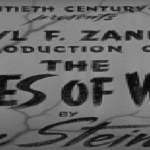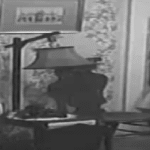White Zombie (1932) is often regarded as the first feature-length zombie film, and while its portrayal of the undead is very different from the flesh-eating ghouls popularised in later decades, its eerie atmosphere and exotic setting established a foundation for the genre. The film is steeped in the mystical and the macabre, drawing heavily on Haitian folklore and the concept of voodoo to craft a tale that is as much about obsession and control as it is about the supernatural.
Set in Haiti, the film begins with a young couple, Madeline Short and Neil Parker, arriving on the island to be married. They are guests of Charles Beaumont, a wealthy plantation owner who has offered them the use of his estate for the ceremony. On the surface, it seems like a generous gesture, but Beaumont’s intentions are far from honourable. He has fallen in love with Madeline and is secretly plotting to win her for himself. Desperate and spurned, he turns to a sinister figure for help: Murder Legendre, a local voodoo master played with chilling intensity by Bela Lugosi.
Legendre is a man of great power, feared across the island for his command over zombies – not the ravenous corpses of modern horror, but vacant, enslaved beings robbed of their souls. They are former men, hollowed out and reanimated through dark arts, now working silently in his sugar mill, their lifeless eyes and mechanical movements reinforcing the horror of their existence. These zombies are not agents of chaos, but victims, living tools bent to the will of their master.
Beaumont pleads with Legendre to help him possess Madeline, not in body alone, but as a companion. Legendre offers a potion that will simulate death, allowing Beaumont to claim her once she is revived under his influence. Reluctantly, and with clear torment, Beaumont administers the potion. Madeline collapses on her wedding night and is buried shortly thereafter, her sudden death shocking Neil and the other guests. Her coffin is quietly exhumed, and she is taken to Legendre’s fortress-like home, where she is reanimated as a blank-eyed shell of her former self, a beautiful but unfeeling spectre.
What follows is a descent into psychological horror, as Neil, stricken with grief and tormented by visions, slowly uncovers the truth. He learns of Legendre’s sorcery and suspects Madeline may still be alive. Driven by love and desperation, he ventures into dangerous territory in search of answers. Meanwhile, Beaumont, despite having what he wished for, begins to regret his actions. He is haunted by the lifelessness in Madeline’s eyes and the realisation that her spirit is gone. His romantic fantasy curdles into horror as he sees the cost of his desire.
Legendre, however, has his own designs. He is not content with being merely a tool for others. As he exerts greater control over Madeline and begins turning Beaumont into one of his own zombie slaves, it becomes clear that his ambition is boundless. Power, for Legendre, is both a drug and a curse. His hold over the dead is absolute, but his isolation is total. There is no joy in what he commands, only domination.
The film’s climax takes place on a cliffside, where Neil confronts Legendre with the help of a local missionary who has studied voodoo. There, amid swirling winds and crashing waves, the truth is laid bare. Beaumont, reduced to a stumbling half-man, tries to fight against Legendre’s will, offering one final act of redemption. In the chaos, Legendre is pushed off the cliff by one of his own creations, his control shattered at last. With his death, the spell is broken, and Madeline is returned to life, her soul and personality restored.
In many ways, White Zombie is as much a tragic tale as it is a horror film. Its central conflict revolves around love warped by obsession and the dangers of seeking unnatural control over others. The zombies, though terrifying in appearance, are more pitiable than monstrous. They are victims, stripped of autonomy, used as labour or pawns in a deadly game. Legendre’s cold, calculating presence looms over every frame, his mastery over life and death underscoring the unnatural imbalance at the heart of the story.
The film’s visual style contributes heavily to its eerie tone. Shadows stretch long across stone walls, and the sets are built with an almost theatrical flair. Lugosi’s piercing gaze is often shot in close-up, drawing the viewer into his hypnotic menace. The use of silence and sound is also notable. Much of the film is devoid of music, relying instead on ambient noises, like the slow rhythm of a drum or the distant howling of the wind, to build tension. This sparseness creates an unnerving atmosphere that seeps into every corner of the narrative.
Despite its short runtime, White Zombie manages to weave a complex and haunting narrative. Its approach to zombies differs significantly from what the genre would become. There is no contagion, no biting, no global apocalypse. Instead, the horror lies in the idea of losing one’s soul, of being trapped in a body that no longer belongs to you. It plays on fears of helplessness, of being reduced to nothing more than an object.
Madeline’s plight is especially tragic. She is the most human character in the story, and her loss of agency serves as a cautionary tale. While Neil’s unwavering devotion is framed as heroic, the film also critiques the selfishness and entitlement that drove Beaumont to such lengths. The true villain, Legendre, stands as a symbol of absolute power unchecked, a reminder that playing with life and death always has consequences.
In conclusion, White Zombie is a film that blends gothic romance with supernatural terror, offering an early exploration of the zombie mythos through the lens of voodoo and colonial anxieties. Its slow pace and dated production may feel antiquated to modern audiences, but its themes remain potent. At its core, it is a story about possession, not just of bodies, but of will, of love, and of identity. As the credits roll and the mist settles over the Haitian hills, what lingers is not just fear, but a sense of melancholy for those who were robbed of themselves, and for those who paid the price for trying to play god.







